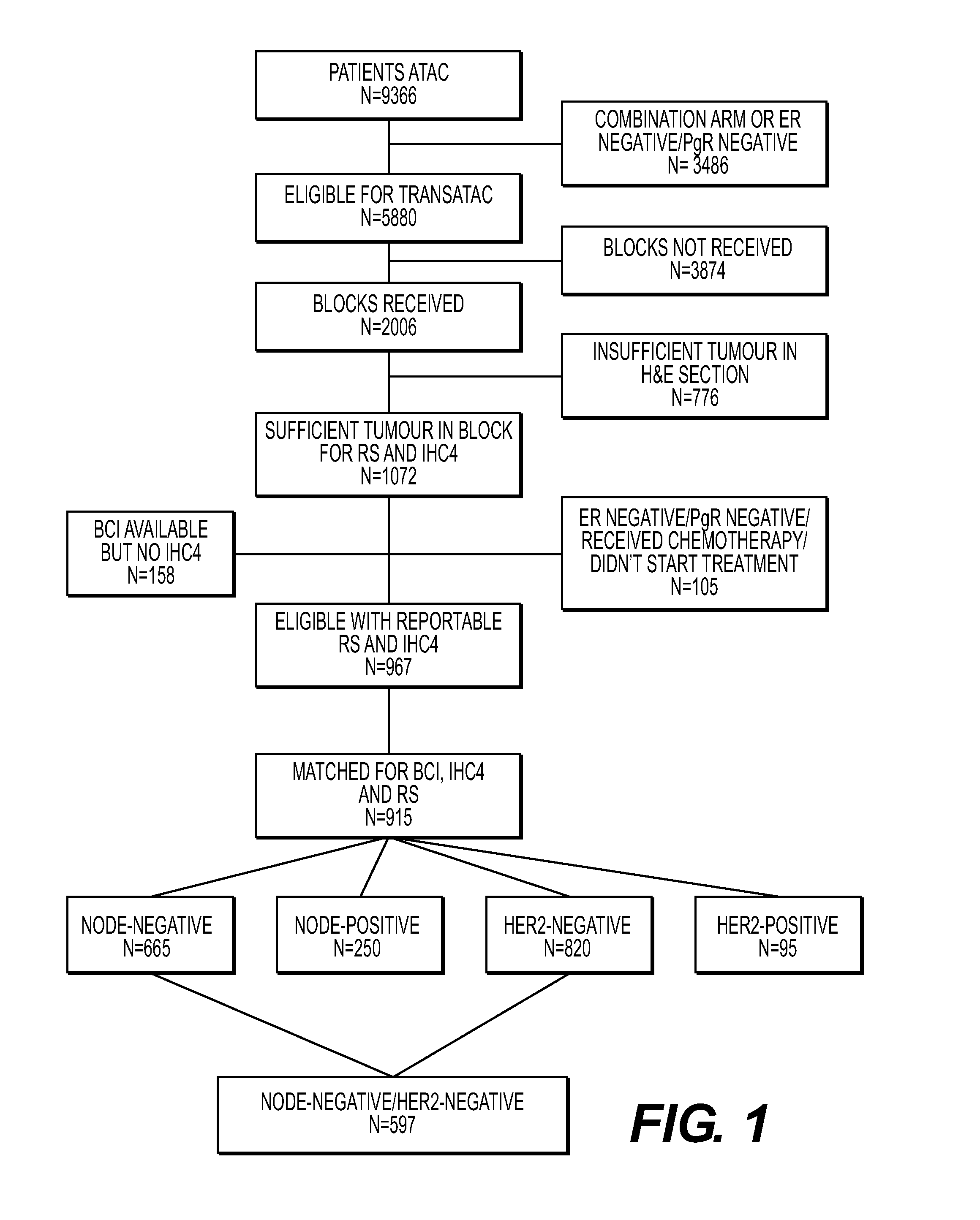Predicting breast cancer recurrence
a breast cancer and gene expression technology, applied in the field of predicting breast cancer recurrence, can solve the problem that the analysis of the plurality of genes provides a risk of cancer recurrence, and achieve the effect of simple and more accurate application of bci and superior prognostic ability for risk of recurren
- Summary
- Abstract
- Description
- Claims
- Application Information
AI Technical Summary
Benefits of technology
Problems solved by technology
Method used
Image
Examples
example 1
Study Design and Patients
[0136]For a prospective comparison study, tissue samples were obtained from the TransATAC project, initiated in 2002 to establish a tissue bank of formalin-fixed paraffin-embedded (FFPE) primary tumor blocks from postmenopausal patients with estrogen-receptor-positive breast cancer from the mono therapy groups of the ATAC trial to assist with translational research (Paik et al., 2004; Dowsett et al., 2010). Archival tumor blocks were requested for all patients for whom the 21-gene recurrence score and IHC4 had already been calculated, except those known to be estrogen-receptor and progesterone-receptor negative according to local tests and those randomly assigned to the combination treatment group of the ATAC trial. The study was approved by the South-East London Research Ethics Committee and the Massachusetts General Hospital Institutional Review Board. Patients had provided written consent for their tissue to be used in further trials.
Procedures
[0137]Previ...
example 2
Patients and Samples
[0143]Values using the 21-gene recurrence score, IHC4, and BCI were calculated for 915 women, of whom 665 had estrogen-receptor-positive, NO breast cancer (FIG. 1). Clinical characteristics of these 665 patients are listed in Table 2 and compared with the characteristics of 561 UK patients with estrogen-receptor-positive, NO breast cancer who participated in the ATAC trial but who were not part of TransATAC. No significant difference between these two groups, except that the non-TransATAC cohort had significantly more well-differentiated tumors and less moderately differentiated tumors than the TransATAC patients, and significantly fewer late distant recurrences.
TABLE 1Patient demographic and clinical characteristicsN0 HER2negN0 UK patientsN0 BCI cohortBCI cohortNon-TransATACTransATACTransATAC*P(n = 665)(n = 597)(n = 561)value#Age, mean63.3(8.1)63.4(8.0)62.6(7.8)0.12(SD)BMI, mean27.1(4.8)27.2(4.8)26.8(5.1)0.28(SD)Tumor size0.13 486(73.1%)442(74.1%)432(77.0%)2-3 c...
PUM
| Property | Measurement | Unit |
|---|---|---|
| time | aaaaa | aaaaa |
| time | aaaaa | aaaaa |
| time | aaaaa | aaaaa |
Abstract
Description
Claims
Application Information
 Login to View More
Login to View More - R&D
- Intellectual Property
- Life Sciences
- Materials
- Tech Scout
- Unparalleled Data Quality
- Higher Quality Content
- 60% Fewer Hallucinations
Browse by: Latest US Patents, China's latest patents, Technical Efficacy Thesaurus, Application Domain, Technology Topic, Popular Technical Reports.
© 2025 PatSnap. All rights reserved.Legal|Privacy policy|Modern Slavery Act Transparency Statement|Sitemap|About US| Contact US: help@patsnap.com



